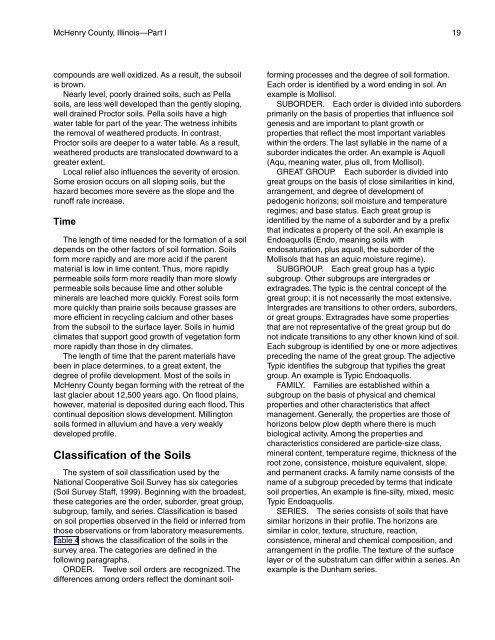Soil Survey of McHenry County, Illinois Part I - Soil Data Mart
Soil Survey of McHenry County, Illinois Part I - Soil Data Mart
Soil Survey of McHenry County, Illinois Part I - Soil Data Mart
You also want an ePaper? Increase the reach of your titles
YUMPU automatically turns print PDFs into web optimized ePapers that Google loves.
<strong>McHenry</strong> <strong>County</strong>, <strong>Illinois</strong>—<strong>Part</strong> I 19<br />
compounds are well oxidized. As a result, the subsoil<br />
is brown.<br />
Nearly level, poorly drained soils, such as Pella<br />
soils, are less well developed than the gently sloping,<br />
well drained Proctor soils. Pella soils have a high<br />
water table for part <strong>of</strong> the year. The wetness inhibits<br />
the removal <strong>of</strong> weathered products. In contrast,<br />
Proctor soils are deeper to a water table. As a result,<br />
weathered products are translocated downward to a<br />
greater extent.<br />
Local relief also influences the severity <strong>of</strong> erosion.<br />
Some erosion occurs on all sloping soils, but the<br />
hazard becomes more severe as the slope and the<br />
run<strong>of</strong>f rate increase.<br />
Time<br />
The length <strong>of</strong> time needed for the formation <strong>of</strong> a soil<br />
depends on the other factors <strong>of</strong> soil formation. <strong>Soil</strong>s<br />
form more rapidly and are more acid if the parent<br />
material is low in lime content. Thus, more rapidly<br />
permeable soils form more readily than more slowly<br />
permeable soils because lime and other soluble<br />
minerals are leached more quickly. Forest soils form<br />
more quickly than prairie soils because grasses are<br />
more efficient in recycling calcium and other bases<br />
from the subsoil to the surface layer. <strong>Soil</strong>s in humid<br />
climates that support good growth <strong>of</strong> vegetation form<br />
more rapidly than those in dry climates.<br />
The length <strong>of</strong> time that the parent materials have<br />
been in place determines, to a great extent, the<br />
degree <strong>of</strong> pr<strong>of</strong>ile development. Most <strong>of</strong> the soils in<br />
<strong>McHenry</strong> <strong>County</strong> began forming with the retreat <strong>of</strong> the<br />
last glacier about 12,500 years ago. On flood plains,<br />
however, material is deposited during each flood. This<br />
continual deposition slows development. Millington<br />
soils formed in alluvium and have a very weakly<br />
developed pr<strong>of</strong>ile.<br />
Classification <strong>of</strong> the <strong>Soil</strong>s<br />
The system <strong>of</strong> soil classification used by the<br />
National Cooperative <strong>Soil</strong> <strong>Survey</strong> has six categories<br />
(<strong>Soil</strong> <strong>Survey</strong> Staff, 1999). Beginning with the broadest,<br />
these categories are the order, suborder, great group,<br />
subgroup, family, and series. Classification is based<br />
on soil properties observed in the field or inferred from<br />
those observations or from laboratory measurements.<br />
Table 4 shows the classification <strong>of</strong> the soils in the<br />
survey area. The categories are defined in the<br />
following paragraphs.<br />
ORDER. Twelve soil orders are recognized. The<br />
differences among orders reflect the dominant soil-<br />
forming processes and the degree <strong>of</strong> soil formation.<br />
Each order is identified by a word ending in sol. An<br />
example is Mollisol.<br />
SUBORDER. Each order is divided into suborders<br />
primarily on the basis <strong>of</strong> properties that influence soil<br />
genesis and are important to plant growth or<br />
properties that reflect the most important variables<br />
within the orders. The last syllable in the name <strong>of</strong> a<br />
suborder indicates the order. An example is Aquoll<br />
(Aqu, meaning water, plus oll, from Mollisol).<br />
GREAT GROUP. Each suborder is divided into<br />
great groups on the basis <strong>of</strong> close similarities in kind,<br />
arrangement, and degree <strong>of</strong> development <strong>of</strong><br />
pedogenic horizons; soil moisture and temperature<br />
regimes; and base status. Each great group is<br />
identified by the name <strong>of</strong> a suborder and by a prefix<br />
that indicates a property <strong>of</strong> the soil. An example is<br />
Endoaquolls (Endo, meaning soils with<br />
endosaturation, plus aquoll, the suborder <strong>of</strong> the<br />
Mollisols that has an aquic moisture regime).<br />
SUBGROUP. Each great group has a typic<br />
subgroup. Other subgroups are intergrades or<br />
extragrades. The typic is the central concept <strong>of</strong> the<br />
great group; it is not necessarily the most extensive.<br />
Intergrades are transitions to other orders, suborders,<br />
or great groups. Extragrades have some properties<br />
that are not representative <strong>of</strong> the great group but do<br />
not indicate transitions to any other known kind <strong>of</strong> soil.<br />
Each subgroup is identified by one or more adjectives<br />
preceding the name <strong>of</strong> the great group. The adjective<br />
Typic identifies the subgroup that typifies the great<br />
group. An example is Typic Endoaquolls.<br />
FAMILY. Families are established within a<br />
subgroup on the basis <strong>of</strong> physical and chemical<br />
properties and other characteristics that affect<br />
management. Generally, the properties are those <strong>of</strong><br />
horizons below plow depth where there is much<br />
biological activity. Among the properties and<br />
characteristics considered are particle-size class,<br />
mineral content, temperature regime, thickness <strong>of</strong> the<br />
root zone, consistence, moisture equivalent, slope,<br />
and permanent cracks. A family name consists <strong>of</strong> the<br />
name <strong>of</strong> a subgroup preceded by terms that indicate<br />
soil properties. An example is fine-silty, mixed, mesic<br />
Typic Endoaquolls.<br />
SERIES. The series consists <strong>of</strong> soils that have<br />
similar horizons in their pr<strong>of</strong>ile. The horizons are<br />
similar in color, texture, structure, reaction,<br />
consistence, mineral and chemical composition, and<br />
arrangement in the pr<strong>of</strong>ile. The texture <strong>of</strong> the surface<br />
layer or <strong>of</strong> the substratum can differ within a series. An<br />
example is the Dunham series.

















